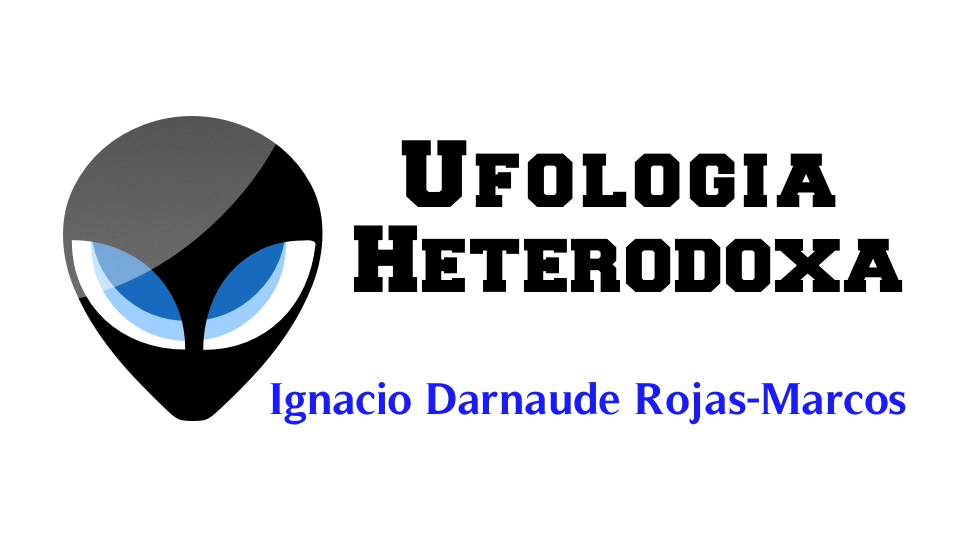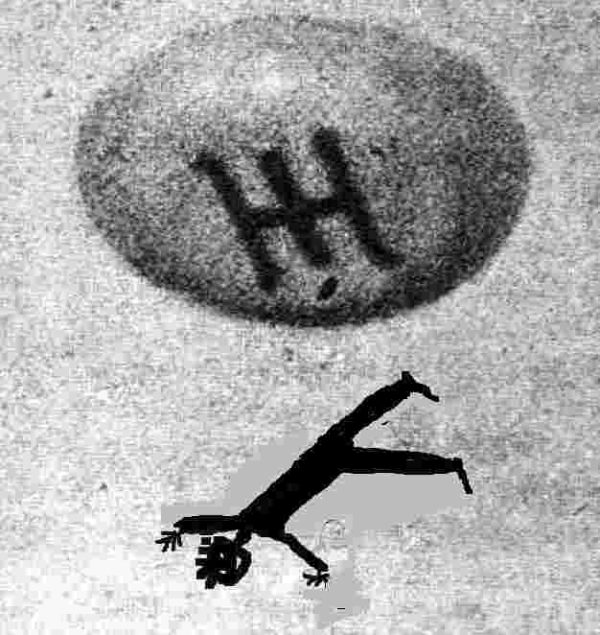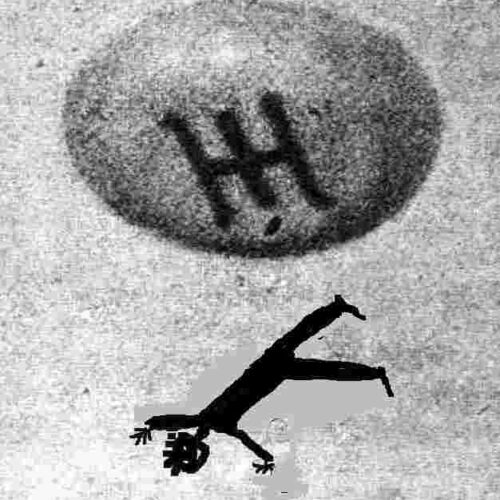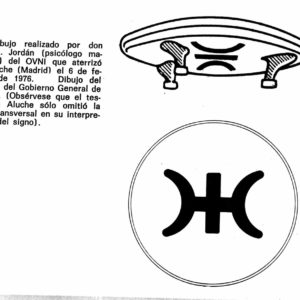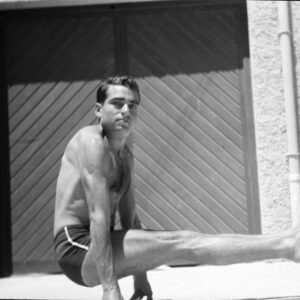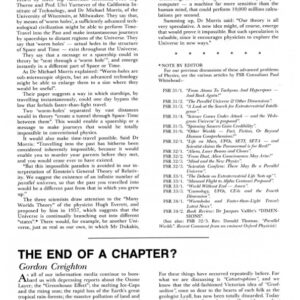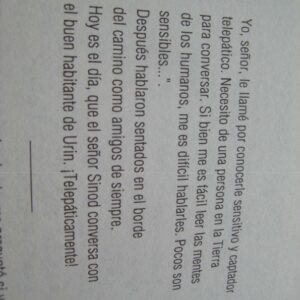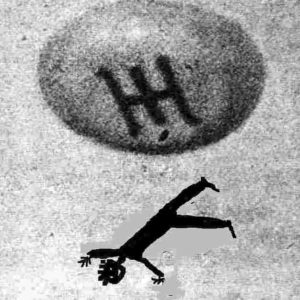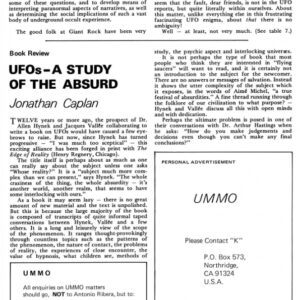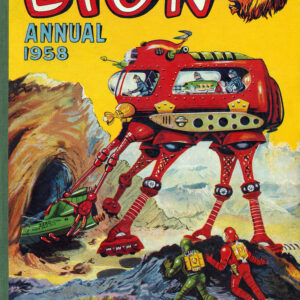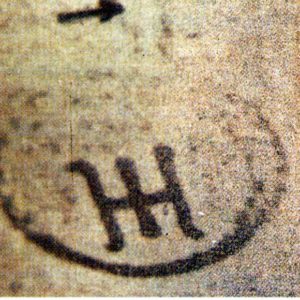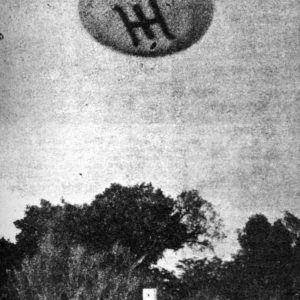Hoax of conspiracy UMMO by Bowen
- Descripción
Descripción
Hoax of conspiracy UMMO by Bowen
19.- Bowen,Ummo,Hoax or conspiracy,FSR80V26N2
T has always ix•en the policy Of this REVIEW to bring to the notice Of its
readers details of items which we have published, which have subsequently
become suspect, or which have been shown to be false. Here — as so much time
has elapsed since publication — are details Of affairs which have fallen into one Of
those categories.
On February 8, 1966, the Spanish newspapers published a report sent to them
by the CIERA Agency to the effect that, at about 8.00 p.m. on the previous day,
an Orange-coloured flying saucer had landed briefly in the grounds Of a house in
the Madrid suburb of Aluche. Two witnesses testified to having seen the object,
and an area of burnt ground was said to have been found at the site. One witness
said his name was Vicente Ortuöo, but the other would not at first reveal his
name for fear Of ridicule.
An account of the event was sent to FLYING SAUCER REVIEW by Antonio Ribera,
who said that in its issue of February 16, 1966, the magazine Porqué carried an
article by special correspondent J _ L _ Pimental who had located and interviewed
the other witness, a Sr. José Luis Jordin. Antonio Ribera and his colleague
Eugenio Danyans followed up the lead. Sr. Jordin wrote to them in great detail,
and described the approach Of a disc-shaped luminous Object, its brief touchdown
and departure. Sr. Jordin, an engineer, had been driving past the grounds Of the
house, and saw the quaintly-curved three-legged landing gear; he told also of
markings on the underside of the object which, as it rose »
. vanished as
though it had suddenly •gone Out • like a light.»
Antonio R ilyra•s article • •The Madrid Landing» was published in FSR Vol.
12, No. 3, May-June 1966.
One year and four months later, in the evening of June 1, 1967, another close
approach Of a disc-shaped Object was claimed to have been observed, and
photographed, by a witness who said that at the time he was taking photographs
of his girl friend in an open space bordering the Extramadura Highway close by
the housing estate of San José de Valderas. The photographer failed to reveal his
identity, and left the negatives at a photographic laboratory for Sr. San Antonio,
photographic reporter of Informaciones. It should bc noted that for this incident Sr.
José Luis Jordin, his appetite whetted by Aluche, had now turned investigator.
A second photographer, who stated that he had been standing near the young
couple, also t€kik some shots Of the Object, and sent two prints to Barcelona writer
Marius Lleget, whose address had been given in a book on UFOs which he had
published. This second photographer signed himself ‘Antonio Pardo»
roughly the equivalent of «Bill Brown» in English — but gave no address and
proved untraceable.
Antonio Ribera and his colleague Rafael Farriols seemed to have been happy
enough with their investigation to publish a book with the confident title Un Caso
Perfecto; FSR carried an article on the case by Sr. Ribera in its issue for
September-October 1969 (Vol. 15, No. 5). The prints of the photographs which
accompanied the article were so enlarged that it could be scen that the grain
structure had not been tampered with. The object was tilted in some Of the
pictures to show the ) sign Of 1966 With the addition of a cross bar to give some
readers details of items which we have published, which have subsequently
become suspect, or which have been shown to be false. Here — as so much time
has elapsed since publication — are details Of affairs which have fallen into one Of
those categories.
On February 8, 1966, the Spanish newspapers published a report sent to them
by the CIERA Agency to the effect that, at about 8.00 p.m. on the previous day,
an Orange-coloured flying saucer had landed briefly in the grounds Of a house in
the Madrid suburb of Aluche. Two witnesses testified to having seen the object,
and an area of burnt ground was said to have been found at the site. One witness
said his name was Vicente Ortuöo, but the other would not at first reveal his
name for fear Of ridicule.
An account of the event was sent to FLYING SAUCER REVIEW by Antonio Ribera,
who said that in its issue of February 16, 1966, the magazine Porqué carried an
article by special correspondent J _ L _ Pimental who had located and interviewed
the other witness, a Sr. José Luis Jordin. Antonio Ribera and his colleague
Eugenio Danyans followed up the lead. Sr. Jordin wrote to them in great detail,
and described the approach Of a disc-shaped luminous Object, its brief touchdown
and departure. Sr. Jordin, an engineer, had been driving past the grounds Of the
house, and saw the quaintly-curved three-legged landing gear; he told also of
markings on the underside of the object which, as it rose »
. vanished as
though it had suddenly •gone Out • like a light.»
Antonio R ilyra•s article • •The Madrid Landing» was published in FSR Vol.
12, No. 3, May-June 1966.
One year and four months later, in the evening of June 1, 1967, another close
approach Of a disc-shaped Object was claimed to have been observed, and
photographed, by a witness who said that at the time he was taking photographs
of his girl friend in an open space bordering the Extramadura Highway close by
the housing estate of San José de Valderas. The photographer failed to reveal his
identity, and left the negatives at a photographic laboratory for Sr. San Antonio,
photographic reporter of Informaciones. It should bc noted that for this incident Sr.
José Luis Jordin, his appetite whetted by Aluche, had now turned investigator.
A second photographer, who stated that he had been standing near the young
couple, also t€kik some shots Of the Object, and sent two prints to Barcelona writer
Marius Lleget, whose address had been given in a book on UFOs which he had
published. This second photographer signed himself ‘Antonio Pardo»
roughly the equivalent of «Bill Brown» in English — but gave no address and
proved untraceable.
Antonio Ribera and his colleague Rafael Farriols seemed to have been happy
enough with their investigation to publish a book with the confident title Un Caso
Perfecto; FSR carried an article on the case by Sr. Ribera in its issue for
September-October 1969 (Vol. 15, No. 5). The prints of the photographs which
accompanied the article were so enlarged that it could be scen that the grain
structure had not been tampered with. The object was tilted in some Of the
pictures to show the ) sign Of 1966 With the addition of a cross bar to give some
resemblance to a symbol in the Cyrillic alphabet. A
further point dealt with in the article was the alleged
discovery of artifacts where another UFO was said to have
landed at Santa M6nica. These consisted Of a number of
small sealed metal tubes, and the press evinced great
interest when a circular letter was received by business
people from a «Henri Dagousset», in which a reward of
18000 pesetas was offered for each tube sent to his
secretary at a Madrid P.O. Box number. A part of a tube
was recovered from a boy, at a small price, by none Other
than the elusive «Antonio Pardo» who sent it, and the
plastic strip it contained, to Sr. Lleget, from whom it was
forwarded to Srs. Ribera and Farriols. The strip had
embossed on it a similar type of sign to that seen on the
belly of the San José de Valderas saucer. The items were
sent for analysis to the Spanish National Technical
Institute for Aeronautics and Space, and the results were
surprising to say the least: the metal was nickel Of». . .an
extraordinarily high degree Of purity, while the plastic
strip was polyvinyl nouride, a type Of plastic at that time
not available commercially. . . and which, up to that
time, had been manufactured only by the American firm
Dupont Nemours. ‘ ‘
‘ ‘Was it an extraterrestrial craft?» asked Sr. Rilx•ra.
While he was not sure on that point, he reiterated that
«the object ‘was there’ all ri t.
With the benefit Of hindsi t it is easy to see that alarm
bells should have ringing about the photographs.
There was another matter engaging our attention,
however, and that was the matter Of the UMMO
documents which had been circulating for some years;
indeed we had been «sitting on them» for a long time,
and continued to do so for several years. The whole
matter was very perplexing, but when the San José de
Valderas photographs turned up one thing was
paramountly obvious, and that was that the sign on the
underbelly of the photographed object was of the same
configuration as the «seal» to be found on the
«authentic» UNIMO documents which were being
distributed around the globe
After much heart-searching, FSR published a summary
Of the events and papers, by Antonio Ribera,
with no outlandish claims being made (in all conscience
the contents Of the documents were sufficiently
outlandish!). It is interesting to note that in one Of his
conclusions Sr. Ribera proposed a hypothesis that
. .some unknown terrestrial agency is trying to discredit
the whole business Of ‘flying saucers’ and
extraterrestrials’ and is launching this complicated
manoeuvre which, when the opportune moment comes,
will be ex osed, thus bringing the most fearful ridicule
upon all tkose who have taken seriously the existence of
‘Ummites’. He thereafter refers to the secret clause, 4a
which was uncovered by the late Dr. James E.
McDonald — added to the recommendations Of the
Robertson Commission Of January 1963, in which the
CIA called for the debunking of saucer reports by the
services,
The five-part UMMO article finally appeared in FSR
Vol. 20, Nos. 4 & 5 (1974) and Vol. 21, Nos. 1. 2 & 3/4
(1975). In FSR Vol. 20, No. 5, Gordon Crei$hton made
«A brief comment on the ‘UMMO• affair» m which he
pointed Out that it had been claimed that
. . it all began
In France in 1950 when the •Ummites’ allegedly made
their first landing at a place near La Javie (Department of
the Basses Alpes). » Apparently the French authorities
were very concerned — as well as, over the years, some
leading French researchers — and helicopters were used
in a search for the lonely farmhouse where the interlopers
allegedly had made their first base. The previous owners
Of the dilapidated farm were discovered living in great
opulence in fine villas on the French Riviera, and were
keeping their mouths shut like clams.
One was forced to concede that if UMMO were a hoax,
then it must a pretty massive undertaking.
In 1977 a bulletin put out by the Center for UFO
Studies, edited by Mrs. Mimi Hynek, carried an analysis
by Dr. Claude Poher Of the San José de Valderas photo-
graphs, and of the UMMO dcxuments, which latter, he
stated, were part of a monstrous hoax — which according
to our information at the time seemed to be something of a
‘U-turn.’
Dr. Poher pointed out that 50% of the information in
the UMMO documents is correct, while the rest is
manifestly false; that the level of scientific knowledge
is about that of the
required to create the documents. . .
first year Of graduate study Of the sciences; that there
seems little probability that the affair could have been
created by only one person.
. and that the background
necessary for such a hoax, if it was a hoax, exceeds the
capabilities of a private group. As for the San José de
Valderas photographs, Dr. Poher had conducted a study
on them over several months using the impressive
facilities Of the National Centre for Space Studies at
Toulouse. He concluded
. that the photographs are a
hoax, produced by using a small model Of translucent
plastic on which the insignia was drawn in ink. This
model was suspended for the photographer by means of a
very fine line, great care being taken not to let the ‘fishing
on the negatives. This explains the normal
line of sight. Dr. Poher felt highly suspicious Of the part
played by the ‘ ‘much-too-omniprescent Sr. Jordan, ‘ ‘ and
States that ‘ . .the entire U M MO affair is tied up with
these sightings IAIuche and San José de Valderas photo-
graphs] and all Of it collapses altogether. ‘ ‘
Dr. Poher’s findings on the photographs were
confirrned by a further in the bulletin under the
signatures of William Spaulding (Director of Ground
Saucer Watch, Western Division) and Fred Adrian
(photographic consultant GSW) Who rformed a
computer photographic analysis of the \ean José de
Valderas photographs. Among their conclusions we read
the object measures less than eight inches in
that .
diameter; the camera was positioned •low’ on the ground
to give the illusion Of ‘object’ height and distance; edge
enhancement revealed a linear Structure representing a
definite sumx»rting thread above the unidentified object.
Unfortunately the picture reproductions in the bulletin
which accompany Bill Spaulding’s analysis do not lend
themselves to further reproduction in FSR. In the cir-
cumstances, as FSR had published the photographs long
before the Center for UFO Studies existed, and as Mr.
Spaulding had already had an article on his computer
experiments published in our journal, we expected the
analyses would be sent to us in due course: they were not.
As time passed, publication of even these basic details was
put aside and overlooked in face Of other problems.
We accept (hen that the San José de Valderas photo.
further point dealt with in the article was the alleged
discovery of artifacts where another UFO was said to have
landed at Santa M6nica. These consisted Of a number of
small sealed metal tubes, and the press evinced great
interest when a circular letter was received by business
people from a «Henri Dagousset», in which a reward of
18000 pesetas was offered for each tube sent to his
secretary at a Madrid P.O. Box number. A part of a tube
was recovered from a boy, at a small price, by none Other
than the elusive «Antonio Pardo» who sent it, and the
plastic strip it contained, to Sr. Lleget, from whom it was
forwarded to Srs. Ribera and Farriols. The strip had
embossed on it a similar type of sign to that seen on the
belly of the San José de Valderas saucer. The items were
sent for analysis to the Spanish National Technical
Institute for Aeronautics and Space, and the results were
surprising to say the least: the metal was nickel Of». . .an
extraordinarily high degree Of purity, while the plastic
strip was polyvinyl nouride, a type Of plastic at that time
not available commercially. . . and which, up to that
time, had been manufactured only by the American firm
Dupont Nemours. ‘ ‘
‘ ‘Was it an extraterrestrial craft?» asked Sr. Rilx•ra.
While he was not sure on that point, he reiterated that
«the object ‘was there’ all ri t.
With the benefit Of hindsi t it is easy to see that alarm
bells should have ringing about the photographs.
There was another matter engaging our attention,
however, and that was the matter Of the UMMO
documents which had been circulating for some years;
indeed we had been «sitting on them» for a long time,
and continued to do so for several years. The whole
matter was very perplexing, but when the San José de
Valderas photographs turned up one thing was
paramountly obvious, and that was that the sign on the
underbelly of the photographed object was of the same
configuration as the «seal» to be found on the
«authentic» UNIMO documents which were being
distributed around the globe
After much heart-searching, FSR published a summary
Of the events and papers, by Antonio Ribera,
with no outlandish claims being made (in all conscience
the contents Of the documents were sufficiently
outlandish!). It is interesting to note that in one Of his
conclusions Sr. Ribera proposed a hypothesis that
. .some unknown terrestrial agency is trying to discredit
the whole business Of ‘flying saucers’ and
extraterrestrials’ and is launching this complicated
manoeuvre which, when the opportune moment comes,
will be ex osed, thus bringing the most fearful ridicule
upon all tkose who have taken seriously the existence of
‘Ummites’. He thereafter refers to the secret clause, 4a
which was uncovered by the late Dr. James E.
McDonald — added to the recommendations Of the
Robertson Commission Of January 1963, in which the
CIA called for the debunking of saucer reports by the
services,
The five-part UMMO article finally appeared in FSR
Vol. 20, Nos. 4 & 5 (1974) and Vol. 21, Nos. 1. 2 & 3/4
(1975). In FSR Vol. 20, No. 5, Gordon Crei$hton made
«A brief comment on the ‘UMMO• affair» m which he
pointed Out that it had been claimed that
. . it all began
In France in 1950 when the •Ummites’ allegedly made
their first landing at a place near La Javie (Department of
the Basses Alpes). » Apparently the French authorities
were very concerned — as well as, over the years, some
leading French researchers — and helicopters were used
in a search for the lonely farmhouse where the interlopers
allegedly had made their first base. The previous owners
Of the dilapidated farm were discovered living in great
opulence in fine villas on the French Riviera, and were
keeping their mouths shut like clams.
One was forced to concede that if UMMO were a hoax,
then it must a pretty massive undertaking.
In 1977 a bulletin put out by the Center for UFO
Studies, edited by Mrs. Mimi Hynek, carried an analysis
by Dr. Claude Poher Of the San José de Valderas photo-
graphs, and of the UMMO dcxuments, which latter, he
stated, were part of a monstrous hoax — which according
to our information at the time seemed to be something of a
‘U-turn.’
Dr. Poher pointed out that 50% of the information in
the UMMO documents is correct, while the rest is
manifestly false; that the level of scientific knowledge
is about that of the
required to create the documents. . .
first year Of graduate study Of the sciences; that there
seems little probability that the affair could have been
created by only one person.
. and that the background
necessary for such a hoax, if it was a hoax, exceeds the
capabilities of a private group. As for the San José de
Valderas photographs, Dr. Poher had conducted a study
on them over several months using the impressive
facilities Of the National Centre for Space Studies at
Toulouse. He concluded
. that the photographs are a
hoax, produced by using a small model Of translucent
plastic on which the insignia was drawn in ink. This
model was suspended for the photographer by means of a
very fine line, great care being taken not to let the ‘fishing
on the negatives. This explains the normal
line of sight. Dr. Poher felt highly suspicious Of the part
played by the ‘ ‘much-too-omniprescent Sr. Jordan, ‘ ‘ and
States that ‘ . .the entire U M MO affair is tied up with
these sightings IAIuche and San José de Valderas photo-
graphs] and all Of it collapses altogether. ‘ ‘
Dr. Poher’s findings on the photographs were
confirrned by a further in the bulletin under the
signatures of William Spaulding (Director of Ground
Saucer Watch, Western Division) and Fred Adrian
(photographic consultant GSW) Who rformed a
computer photographic analysis of the \ean José de
Valderas photographs. Among their conclusions we read
the object measures less than eight inches in
that .
diameter; the camera was positioned •low’ on the ground
to give the illusion Of ‘object’ height and distance; edge
enhancement revealed a linear Structure representing a
definite sumx»rting thread above the unidentified object.
Unfortunately the picture reproductions in the bulletin
which accompany Bill Spaulding’s analysis do not lend
themselves to further reproduction in FSR. In the cir-
cumstances, as FSR had published the photographs long
before the Center for UFO Studies existed, and as Mr.
Spaulding had already had an article on his computer
experiments published in our journal, we expected the
analyses would be sent to us in due course: they were not.
As time passed, publication of even these basic details was
put aside and overlooked in face Of other problems.
We accept (hen that the San José de Valderas photo.
graphs were the result Of an elaborate hoax, and that there
have been some tie-up between them and the Aluche
sighting. However, we cannot agree that the U M.MO
house Of cards comes tumbling down because of the faked
photographs. The alleged connection between the photo-
graphs and the UMNIC) affair is the symbol — which
some say is like a letter in the Cyrillic alphabet. But
U M MO documents were in circulation long before the
appearance Of the taked photographs. and it is not beyond
the bounds Ol- possibility that the hoaxer could have got
the idea ‘Or the symbol painted on the underbelly of his
model from the ‘ ‘seal’ • on an U MMO document.
As for the statements contained in the UNIMO
documents, the quality of most of these seem to about
par for the contactee message course. so who could have
been involved in an undertaking of the size of UMMO?
Could it have been a terrestrial agency bent on bringing
ufology into disrepute? Could it have been such a
conspiracy? Reading between Dr. Poher•s lines
C’ _ _ _ background necessary for such a hoax, if it was a
hoax, • exceeds the capabilities Of a private group») we
suspect that either he may have learned something about
some covert official involvement, or that he was tired of
the affair and wished to have done with it. Antonio
Ribera’s hints about the CIA were quite open and,
despite that Agency’s protests that it had closed its UFO
files in 1952, papers revealing its continued interest in the
subject were recently winkled out Of it by William
Spaulding and his Ground Saucer Watch in a Freedom of
Information lawsuit.
So was there a debunking conspiracv? If it was
engineered by some terrestrial agency then it misfired.
the U M.M() process • •ground exceeding slow • • and. as
as We can tell. the ridicule didn’t result in nation-wide rib•
splitting Inirth in Spain. let alone in the rest of the «orld.
• Editor’s ernphasi•s: Dr. Poher adopts
paragraph’ earlier in Bulletin
the
monstrous hoax,’
One of the San José de Valderas hoax
photographs.
As far as we can see it seems unlikelv that any terrestrial
agencv was involved.
leaves us wondering whether or not the stimulus
for the wretched U.M.M() business mav have conic ii•om
sornething else. Sotnething with a vested interest in
sowing confusion among the ranks oi those caught up in
the UF() mvsterv.
PRICE INCREASE
Inflation, which to us means increases in the cost of printing, paper and envelopes, postage,
telephone charges and so on, has forced on us another increase in the price Of Flying Saucer
Review.
With effect from this issue the cover price will be El .00, and the subscription E5.70 per annum. The
prices of back numbers have also been adjusted.
This, and the continuing rise in the rate Of exchange Of the pound against the IJS dollar means a
further revision in the dollar price. This will now be USS2.45 per copy, with a subscription rate of
US$14.OO. While these figures are calculated to cover banks’ exchange commission on personal
cheques, readers in the United States, and indeed in all countries overseas. are still recommended
to remit the above-stated British Sterling amount by bank draft or money order, which means the
subscriber doesn’t pay more than he or she needs to pay, and we receive the correct amount.
have been some tie-up between them and the Aluche
sighting. However, we cannot agree that the U M.MO
house Of cards comes tumbling down because of the faked
photographs. The alleged connection between the photo-
graphs and the UMNIC) affair is the symbol — which
some say is like a letter in the Cyrillic alphabet. But
U M MO documents were in circulation long before the
appearance Of the taked photographs. and it is not beyond
the bounds Ol- possibility that the hoaxer could have got
the idea ‘Or the symbol painted on the underbelly of his
model from the ‘ ‘seal’ • on an U MMO document.
As for the statements contained in the UNIMO
documents, the quality of most of these seem to about
par for the contactee message course. so who could have
been involved in an undertaking of the size of UMMO?
Could it have been a terrestrial agency bent on bringing
ufology into disrepute? Could it have been such a
conspiracy? Reading between Dr. Poher•s lines
C’ _ _ _ background necessary for such a hoax, if it was a
hoax, • exceeds the capabilities Of a private group») we
suspect that either he may have learned something about
some covert official involvement, or that he was tired of
the affair and wished to have done with it. Antonio
Ribera’s hints about the CIA were quite open and,
despite that Agency’s protests that it had closed its UFO
files in 1952, papers revealing its continued interest in the
subject were recently winkled out Of it by William
Spaulding and his Ground Saucer Watch in a Freedom of
Information lawsuit.
So was there a debunking conspiracv? If it was
engineered by some terrestrial agency then it misfired.
the U M.M() process • •ground exceeding slow • • and. as
as We can tell. the ridicule didn’t result in nation-wide rib•
splitting Inirth in Spain. let alone in the rest of the «orld.
• Editor’s ernphasi•s: Dr. Poher adopts
paragraph’ earlier in Bulletin
the
monstrous hoax,’
One of the San José de Valderas hoax
photographs.
As far as we can see it seems unlikelv that any terrestrial
agencv was involved.
leaves us wondering whether or not the stimulus
for the wretched U.M.M() business mav have conic ii•om
sornething else. Sotnething with a vested interest in
sowing confusion among the ranks oi those caught up in
the UF() mvsterv.
PRICE INCREASE
Inflation, which to us means increases in the cost of printing, paper and envelopes, postage,
telephone charges and so on, has forced on us another increase in the price Of Flying Saucer
Review.
With effect from this issue the cover price will be El .00, and the subscription E5.70 per annum. The
prices of back numbers have also been adjusted.
This, and the continuing rise in the rate Of exchange Of the pound against the IJS dollar means a
further revision in the dollar price. This will now be USS2.45 per copy, with a subscription rate of
US$14.OO. While these figures are calculated to cover banks’ exchange commission on personal
cheques, readers in the United States, and indeed in all countries overseas. are still recommended
to remit the above-stated British Sterling amount by bank draft or money order, which means the
subscriber doesn’t pay more than he or she needs to pay, and we receive the correct amount.
